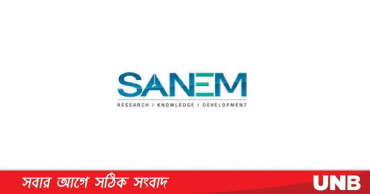South Asian Network on Economic Modeling
Iran-Israel conflict heightens oil price uncertainty, poses threat to Bangladesh’s economy
The escalating Iran-Israel conflict is heightening economic uncertainty for Bangladesh, prompting economists and analysts to urge immediate preparedness for its potential impacts.
“A sustained escalation in the Middle East could trigger a cascade of challenges, primarily driven by surging global oil prices, disrupted trade routes, and potential impacts on remittance inflows, threatening Bangladesh's economic stability and growth trajectory,” said Dr Selim Raihan, Professor of Economics at the University of Dhaka and Executive Director of the South Asian Network on Economic Modeling (SANEM).
Talking to UNB, Dr Raihan said Bangladesh, as an increasingly export-oriented economy, is heavily reliant on smooth international trade and stable energy prices.
The Ready-Made Garment (RMG) sector, which accounts for over 83 percent of the country's total export earnings, is highly vulnerable to global economic disruptions. Secure trade routes and stability in the US and European markets are essential for sustaining RMG exports, he said.
Dr Raihan also pointed out that Bangladesh’s energy security is deeply linked to imports, particularly those passing through the Strait of Hormuz, a vital global shipping corridor that handles about one-fifth of the world’s oil supply. Any disruption in shipments through this route could severely affect the country's economy.
Meanwhile, Dr Muhammad Fouzul Kabir Khan, energy adviser to the interim government, said the oil supply chain is likely to remain stable, but uncertainty surrounds the supply of liquefied natural gas (LNG).
Purchase body approves proposals to procure rice bran oil, LNG cargo
Global oil prices have already surged in response to rising tensions, with Brent crude and West Texas Intermediate (WTI) both recording sharp increases. Experts warn that a prolonged conflict, especially one that disrupts the Strait of Hormuz, could drive oil prices up to US$90–$120 per barrel.
For a country like Bangladesh, which is heavily dependent on imported fuel, such a scenario could lead to a skyrocketing import bill.
“Countries like Bangladesh, which rely heavily on oil imports, will be among the hardest hit,” said Dr Mustafizur Rahman, a distinguished fellow at the Centre for Policy Dialogue (CPD).
He warned that a spike in oil prices would act as a “barometer of commodity prices in the global market,” triggering inflation across various domestic sectors and placing immense pressure on household budgets.
In addition to energy concerns, the escalating tensions also threaten global trade and supply chains. Ongoing Houthi militant attacks in the Red Sea have already disrupted major shipping routes to Europe, pushing global logistics costs up by over 20 percent.
A prolonged conflict would likely worsen these disruptions, raising the cost of importing essential raw materials and finished goods, while also increasing shipping costs for Bangladesh’s exports. This would erode the competitiveness of the RMG sector, which depends on timely and cost-effective logistics.
Airspace closures across the Middle East have further complicated international aviation routes, raising operational costs for both cargo and passenger movement.
Mahmud Hasan Khan Babu, President of the Bangladesh Garment Manufacturers and Exporters Association (BGMEA), told UNB that the garment industry has kept its production running even during energy shortages.
Israel-Iran conflict enters third day with escalating missile strikes, rising death tolls
Another blow in the form of price hikes or supply disruptions could be devastating, especially after the challenges faced during the COVID-19 pandemic.
Remittances, a crucial pillar of Bangladesh’s economy and a key source of foreign exchange, also face potential, albeit indirect, risks.
Although recent figures show strong remittance inflows supporting the recovery of foreign exchange reserves, prolonged instability in the Middle East could affect the employment and earnings of millions of Bangladeshi expatriate workers in the region.
Should security conditions deteriorate in host countries, future remittance inflows may decline, placing further pressure on the country’s foreign currency reserves, which are already strained by rising import payments.
According to Bangladesh Bank, gross foreign exchange reserves have recently recovered to over US$25 billion.
These reserves remain vulnerable to external shocks. A sustained rise in import costs, due to higher oil prices and increased shipping expenses, could rapidly deplete reserves, making it difficult to finance essential imports and maintain macroeconomic stability.
Economists urged the government to stay vigilant and proactive by developing contingency strategies.
These include diversifying energy sources, exploring alternative trade routes, and providing targeted support to the RMG sector to cushion the blow of global instability.
Trump blocked Israeli plot to assassinate Iran’s Khamenei: Reports
The ripple effects of a prolonged Iran-Israel conflict could severely dampen Bangladesh’s economic outlook, potentially slowing GDP growth and heightening inflationary pressure on its population, they said.
6 months ago
Bangladesh received $2.16 billion remittances in February, highest in fiscal
Bangladesh received inward remittances of USD $2.16 billion in February, which is the highest in 8 months (July-February) in the current fiscal year 2023-24.
According to the provisional data of the Bangladesh Bank (BB) revealed on Sunday, the expatriates sent $2.16 billion remittance to the country through the legal channel. In the previous month January, the expatriates had sent $2.10 billion in remittances.
Bangladesh has received so far $13.26 billion in inward remittances in the first eight months of the year through the legal channel.
Md Mezbaul Haque, BB spokesperson, told UNB that inward remittances flow increased in the legal channel as the government and banks are providing incentives.
Read more: Brac Bank introduces digital Form C, electronic document submission platform for commercial remittances
He said the central bank instructed banks to provide additional incentives from their financial sources, which keeps a role in increasing the flow of inward remittances in the legal channel.
With the government's 2.5 percent incentive on expatriate income, banks can buy dollars at an additional 2.5 percent higher price. A total of 5 percent is getting incentives. As a result, remittances are coming to the country through legal channels.
The executive director of the private research institute South Asian Network on Economic Modeling (SANEM) Prof Dr. Selim Raihan said that a total of 5 percent incentive on remittances will help to boost remittances temporarily. But there will be no long-term solution.
Dr. Raihan said,”To increase remittances, hundi should be stopped. If you want to stop hundi, you have to stop money laundering. Now a lot of money is being smuggled abroad. It has to be controlled by any means.”
Read more: How to safely send remittance to Bangladesh?
1 year ago
Garment workers have little access to Covid-19 vaccine information, says a study
The country’s garment workers have little access to adequate information related to COVID-19 immunization, according to a joint survey by the South Asian Network on Economic Modeling (SANEM) and Microfinance Opportunities (MFO).
The survey found that only 22% of the workers who wished to be vaccinated had information on how to gain access to jabs, Sanem said a press release on Sunday.
“This is a concern because inability to ensure access to COVID-19 vaccines will put millions of garment workers, who are employed in one of our most crucial industries, at risk,” it said.
READ: Focus on policy reforms to boost private sector investment: SANEM
In order to facilitate the recovery process of RMG production, export and the economy as a whole, factory owners, government officials, policymakers and advocacy groups will have to come together to prioritize the health and safety of workers.
SANEMand and MFO have been jointly conducting a series of surveys to better understand how the lives of garment workers in Bangladesh have evolved during the COVID-19 crisis.
The press release said that the ready-made garment industry in Bangladesh
which has been one of the key drivers of economic growth, has faced challenges since the start of the pandemic. Consequently, the lives of the workers employed by the sector have been affected in various ways.
READ: 68% of businesses yet to receive any stimulus: SANEM
Under the title "Garment Worker Diaries", SANEM and MFO have been collecting monthly data since April 2020 on the employment, income, food security, wage digitization and health of garment workers employed in factories across the five main industrial areas of Bangladesh (Chittagong, Dhaka City, Gazipur, Narayanganj, and Savar).
The data disclosed were collected from a pool of 1,285 workers during surveys conducted over the phone on April 23, 2021.
Just over three-quarters of the working respondents are women, roughly representative of workers in the sector as a whole. The survey focused on COVID-19 lockdown conditions as well as on garment workers’ awareness of and opinions about COVID-19 vaccinations.
Despite the nationwide lockdown, garment-producing factories across the manufacturing sector were allowed to operate with strict guidelines in place.
However, in the absence of sufficient public transport, some apparel workers could not commute to their factories as they normally would: 8% of the workers surveyed told us they had to use alternative means to get to work.
READ: SANEM finds 70% wage-earners in 4 dists. worse off in a year
Further, only 4% of surveyed workers reported using factory-provided transportation, indicating that not all factories took the necessary measures to ensure transportation to work for those workers who are reliant upon it.
As it stands though, 76% of the surveyed workers reported that they walk to their workplaces, while only 10% used rickshaws, 6% used auto-rickshaws, 2% used bus, and 2% used CNGs.
Finally, 92% of the surveyed workers also reported that there was no change in their means of transport, indicating that the majority of workers usually travel to work on foot anyways.
Only 2% of the surveyed workers had received the COVID-19 vaccine prior to the survey. On being asked whether they think they are eligible to get vaccinated, 36% of respondents said they were eligible, 28% said they were not eligible, and 34% said they did not know if they were eligible.
Among the 36% of respondents said they were eligible for the vaccine, 76% said they want to get vaccinated.
Among the 28% of respondents stated that they were not eligible for the vaccine, 63% said they would get the vaccine if they became eligible.
And among the 34% of respondents who weren’t sure if they were eligible, 65% said they would get the vaccine if in fact they were eligible
Overall, 69% of respondents said they were willing to get vaccinated if they were eligible to get the vaccine whereas 31% said they did not want to get vaccinated.
Out of the 31% who were unwilling to get the vaccine, 48% were afraid of side-effects, falling ill or dying, 23% did not feel the necessity or the benefit of getting vaccinated, 17% said they would rely on their religious faith to stay protected, 3% said they were pregnant or suffering from other health problems or allergies, 2% said they were prohibited by their husband, a little less than 1% said they were waiting for everyone else to get vaccinated, and 7% gave us some type of other response.
4 years ago
Focus on policy reforms to boost private sector investment: SANEM
Economists at a webinar on Sunday urged the government to focus on policy reforms to boost private sector investment which is essential to stimulate the post-COVID recovery process.
They also remarked that in the absence of comprehensive data collected by national statistical agencies such as Bangladesh Bureau of Statistics (BBS), it is extremely challenging for policymakers to identify, target or design effective policies to help the worst affected groups of the populations.
The observations came up with the webinar organized by South Asian Network on Economic Modeling (SANEM) titled “Budget 2021-22: Reality and Expectations” to discuss the importance of the national budget in addressing the challenges of the ongoing pandemic.
READ: 68% of businesses yet to receive any stimulus: SANEM
Dr Selim Raihan, Professor of Economics Department at Dhaka University and Executive Director of SANEM said since the budget for FY 2021-22 is going to be the second budget announced during the pandemic, policymakers should primarily focus on addressing the urgent needs that have emerged due to the ongoing crisis.
“It is extremely important for the policymakers to come to terms with the reality of the current situation and acknowledge the gravity of the socioeconomic crisis that the country is currently facing," he said, stressing upon the importance of COVID-19 management related budget allocations to salvage the health sector through ensuring timely vaccination drives, border controls and building capacity of the medical workforce.
One of the key issues that he highlighted is the lack of proper data collection and monitoring since the beginning of the pandemic.
He also referred to the findings of SANEM’s ongoing quarterly Business Confidence Survey which reveal that micro, small and medium enterprises (MSMEs) have been most negatively impacted due to the pandemic.
Despite the severity of the impact, government stimulus packages for MSMEs have been inadequate, making it even more difficult for them to survive through this unprecedented crisis. As these MSMEs play a vital role in the supply chain and also create employment opportunities for the majority of the workers working in the informal sector, recovery of the MSMEs is a major contributing factor to the recovery of the economy as a whole.
Dr Raihan mentioned that, although GDP growth rate is an important measure to assess the advancement of the economy, it is high time for policymakers to come out of the obsession of repeatedly using GDP and instead focus on socioeconomic indicators such as poverty, inequality and employment to assess the wellbeing of the nation.
“The government needs to properly define the corporate social responsibility of the various business associations. Business associations have an important role to play in this time of crisis. But unfortunately we have seen that at this time they are more occupied with their own demands,” the economist added.
Dr Sayema Haque Bidisha, Professor of Economics Department at Dhaka University and Research Director of SANEM delivered the keynote presentation.
Dr Sayema acknowledged that the budget for the next fiscal year would have to consider both pre-COVID as well as post-COVID challenges.
She pointed out that the existing budget structure suffers from low revenue generation and slow implementation of ADP. Furthermore, despite the consistently high growth in GDP, the pace of employment generation has not been impressive and there has been low spending in human resource development.
“In addition, the pandemic has now impacted the livelihoods of millions due to job losses, business closures and reduction in income. A digital divide has become evident in the education sector and rise in dropout rates and early marriages have emerged as major concerns. In this context, the upcoming fiscal budget will play a critical role in dealing with the pandemic fallouts,” she added.
The presentation highlighted a declining trend in revenue collection in the recent budgets: 83% of the actual revenue target was met in the fiscal year 2016-17 which decreased to 75% in 2017-18 and 74% in 2018-19.
A closer analysis of the composition of the NBR tax revenue reveals that the proportion of income tax in the overall revenue has also declined over the past 5 years. In the fiscal year 2016-17, income tax made up 35.4% of the total tax revenue while in 2021, it declined to only 31.5%.
READ: SANEM finds 70% wage-earners in 4 dists. worse off in a year
The government’s Annual Development Programme (ADP) implementation rate has also been staggeringly low in the current fiscal year. ADP implementation progress over July 2020-April 2021 has been below 50% across several key ministries and divisions including Health Services Division, MoPME, MoHPW, Ministry of Industries, Medical Education and Family Welfare Division, MoWCA, MoSW, Food, Labor and Employment, Planning Division. Furthermore, government domestic borrowing in financing the national budget has also increased from 14.8% in FY 2019-20 to 19.4% in FY 2020-21.
Dr Sayema stressed that the prime objective of the upcoming fiscal budget should be to ensure better health management while restoring the income level of people through employment generation. To attain this objective, she mentioned four key areas of priority: Health, Education, Social Safety Net and Agriculture.
4 years ago
SANEM finds 70% wage-earners in 4 dists. worse off in a year
The monthly income of wage-earners in four select districts came down around 70 percent in a year (November 2019 to November 2020), according to a SANEM survey unveiled on Tuesday.
4 years ago
SANEM takes on post-Covid challenges in Bay of Bengal
Speakers at a webinar on Monday underscored the need for joint strategies among the communities in Bay of Bengal for the sake of sustainable development.
4 years ago
SANEM survey: Population below poverty line doubled, extreme poor trebled in 2020
The South Asian Network on Economic Modeling (SANEM) on Saturday said the percentage of the population living below the poverty line (upper poverty line) has nearly doubled from 21.6% in 2018 to 42% in 2020, while the percentage of extreme poor (lower poverty line) trebled from 9.4% in 2018 to 28.5% in 2020.
4 years ago
'Syndicates take advantage of data scarcity to raise prices': SANEM
The Executive Director of the South Asian Network on Economic Modeling (SANEM) Dr Selim Raihan on Saturday urged the government agencies to monitor the essentials market throughout the year, coordinating among the concerned departments and resolving data scarcity to control the market.
5 years ago
Emerging out of Pandemic calls for inclusive policies: Speakers at Sanem conference
Speakers in a series of webinars organized by the South Asian Network on Economic Modeling, or Sanem, underscored the need for more inclusive policies for developing countries to resolve the problems created by COVID-19 pandemic.
5 years ago
Better coordination among stakeholders needed for youth development: Minister
Planning Minister MA Mannan on Saturday stressed the need for better coordination among public, private stakeholders and experts for the sake of the country’s youth development as they are key force of economic development.
5 years ago


.jpg)
.jpg)









